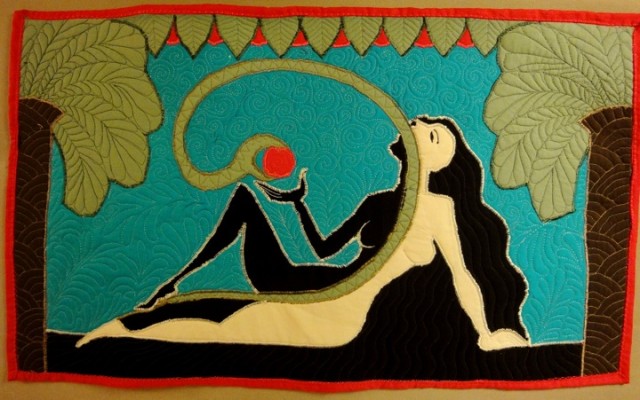Last night I was a guest on 2600’s Off the Hook hacker radio show. I start ranting about copyright about 1/4 of the way in, and keep going until the end. Listen here.
Category: the interwebs
My New Hobby
is sewing/quilting/embroidery/textile arts.
Here’s my first quilt ( a small one, 29″ x 17.5″) which I finished last night. It’s for my Momz, who requested “a nude with all the bells and whistles.”
Everything I learned from teh interwebs, which is full of quilting information and many good videos. I especially like the web site & videos of Leah Day, who makes free motion quilting look much easier than it is. Leah shares her videos and knowledge freely, which works – I’m a fan now, and spent over $250 at her online quilting store. It’s a business model I’m familiar with.
Speaking of business models, there’s an argument made by copyright advocates that no one would do anything creative without monetary (or monopoly) incentives:

My past few weeks exploring quilting confirms this is absolutely not true. In less than a month of getting myself set up with a sewing machine, fabric, threads, and other supplies, I’ve probably shelled out $1,000. It started with an inexpensive sewing machine ($250), but then I needed special feet for it, and cutters, and an iron, and pins, and threads, and batting, and fabric, and a sewing table, and IKEA drawers to hold all this stuff, and on and on. And that was being budget-conscious; I could easily spend a lot more. In fact I really, really want a longer machine with more space under the arm; unfortunately those cost about $3,000.
I’m not alone: tens if not hundreds of thousands of Americans pay for the privilege to create, not the other way around. Most quilters are not paid; most actually give their work away, to family, friends and charities. That’s folk art, people: it’s not done for money. And yes, it is art.
It’s very much like filmmaking, which is now a folk art.
“The film business has never been a business. It’s always been a hobby.” –someone whose name I don’t remember at a film conference I attended last year
Even setting aside independent film productions, which are hobbies in business clothing, most people spend more on video cameras and computers than they’ll ever get back selling their work. With the spread of cheap animation software, animation is now a folk art too. With the rise of print-on-demand self-publishing, novel-writing is also becoming folk art (Pirates of Savannah by Tarrin Lupo is what I’d call a folk art novel). All the super-elite arts of the 20th Century are becoming folk art.
Would I still like to make money with this? Yes, I would. But I’ve already spent plenty of money with no promise of monetary return. It’s been worth it so far, because learning has been exhilarating. Hopefully traditional folk arts, like quilting, will continue to gain respect as “real” art, even as “real” arts are adopted by the masses. I confess I would like to sell original pieces, if I keep making them. It’s really up to my Muse.
After the jump are some pictures of the making of “Eve,” which took 3 days (4 if you include the day I designed it):
correction again, again
I’m reposting this (originally posted July 2009) for a third time, because misinformation continues to spread all over the interwebs. I should post it more often.
Dear Journalists Dear Journalists, bloggers, commenters, etc.,
Some of you are writing that I was forced to choose the Creative Commons Attribution Share Alike license because the film is violating copyright. That is completely untrue, but has become the dominant motif of stories I read about the project. The confusion is understandable, so I attempt to sort it out below.
Sita Sings the Blues is 100% legal. I am free to release it commercially, which is why the film is gaining a number of commercial distributors in addition to its free sharing/audience distribution, which is also legal, and wonderful.
Sita Sings the Blues is in complete compliance with copyright regulations. I was forced to pay $50,000 in license fees and another $20,000 in legal costs to make it so. That is why I am in debt. My compliance with copyright law is by no means an endorsement of it. Being $70,000 in the hole reminds me daily what an ass the law is. The film is legal, and that legality gives me a higher moral ground to stamp my feet upon as I denounce the failure that is copyright.
Having paid these extortionate fees, I could have gone with conventional distribution, and was invited to. I chose to free the film because I could see that would be most beneficial to me, my film, and culture at large. A CC-SA license does not absolve a creator of compliance with copyright law. The law could have sent me to prison for non-commercial copyright infringement. I was forced to borrow $70,000 to decriminalize my film, regardless of how I chose to release it.
Note that in some ways the film is not, and never will be free. For each disc sold, distributors must pay $1.65 to these faceless money sinks. Transaction costs raise that amount to about $2.00 per disc. That is why my own Artist’s Edition is limited to 4,999 copies. I’ve already bled $50,000 into their vampiric maws; I have no intention of paying more.
Thank you for your attention.
Love,
–Nina
Linear Growth
Above are the Feedburner stats for Mimi & Eunice. The green line represents subscribers; the blue represents “reach” (“the total number of people who have taken action — viewed or clicked — on the content in your feed”). The lines represent an overall trend of linear growth. Not exponential growth. Which is fine, but makes me wonder: is “viral” (exponential) sharing becoming a thing of the past, as quality content on the internet becomes more ubiquitous?
A few years ago, if you put anything halfway decent online it would spread like a virus. The online memosphere was less colonized than it is today. Of course there will still be “viral” content, but it has a lot more to compete with today: all the other viral content. Imagine if you released something of today’s quality online 10 years ago. It would have spread further and faster back then, because attention wasn’t already consumed by vast amounts of other quality content. On the other hand, the internet itself was much smaller 10 years ago – fewer people had access to it – so overall reach of a viral success could have been lower in absolute terms.
I’ve noticed the linear trend in most of my works now (sitasingstheblues.com, having enjoyed exponential growth followed by a plateau, is now on a linear decline). Maybe this means my work sucks, but I don’t think so. I’m happy with linear growth. But I am revising my ideas about “viral content,” and I wonder if others are, too. Twitter’s “Trending: Worldwide” lists indicate some things spread virally – suddenly they’re everywhere – but then they’re gone the next day, and forgotten in a week.
What does this all mean? Does it mean anything? As an artist, should I care?

Face-O-Matic
On a lighter note, enjoy this online toy coded by my friend Margo Burns. It is based on “Face-O-Matic” cards I originally designed to teach very inhibited grad students to draw cartoon facial expressions for a visual storytelling class at Parsons. Turns out all ages enjoy it. The drawings are extremely simple, so even people who claim they have no drawing skills can copy them without fear.
Authoritarian update
crossposted from Mimi & Eunice
I’m re-posting this cartoon today because the US Department of Homeland Security seized more than 70 web sites over the weekend (while sites like arstechnica.com and techdirt were on vacation, and the mainstream media were devoted to stories about holiday shopping). Democrats: unless you stand up to stop this NOW, I am never voting for you again.






